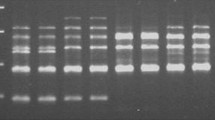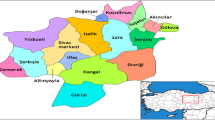Abstract
In clonal grapevine populations, genetic factors may have a significant effect on the amount of phenolic compounds in the grape berries. Thus, the capacity of the clones to produce distinctive chromatic profiles can be improved. This paper describes the phenolic contents and composition of grape berries as well as relationships among them for Kalecik Karası clones to reveal their wine quality potentials. Seven individual polyphenols were quantified using high-performance liquid chromatography. The clones showed a significant difference (5.01 mg kg−1 protocatechuic acid and 18.80 mg kg−1 gallic acid) in berry phenolic compounds. Cluster analysis and multidimensional scaling were performed, and results showed that clones were clustered into three groups regarding phenolic compounds in the berries. Based on the phenolic compounds, 18 of the 23 clones were clustered into a group. Clones 16, 13, 8, and 2 were grouped together, while clone 7 was separated from the others. Including and excluding clone 7, approximately 40% phenotypic variation and 80% similarity were observed in ‘Kalecik Karası’ clones, respectively. There were positive correlations between clones 2, 6, 7, 9, and 13 and p-coumaric, ferulic, gallic, and protocatechuic acids, as well as between clones 3, 5, 10, 14, 15, 34, 16, 19, and 20 and q‑coumaric, vanillic, and syringic acid contents. Thus, it can be stated that multivariate methods can be used for clonal selection, and exclusive clones can be selected with high values of phenolic compounds in the future.



Similar content being viewed by others
References
Anderson M, Smith R, Williams M, Wolpert J (2008) Evaluation of French and California Pinot noir clones grown for the production of sparkling wine. Am J Enol Vitic 59:188–193
Artem V, Geana EI, Antoce AO (2014) Study of phenolic compounds in red grapes and wines from Murfatlar wine center. Ovidius Univ Ann Chem 25(1):47–52
Ağaoğlu YS (1999) Scientific and applied viticulture (grapevine biology). Ankara Univ. Agriculture Faculty.. Kavaklıdere Education Publications, Ankara
Barbeau G, Cousin M, Blin A, Panneau J‑P, Bouvet M‑H, Mège A (1999) Méthodologie de sélection clonale chez la vigne (Vitis vinifera). Prise en compte de la précocité du cycle et de l’interaction clone*terroir. Bull Oiv 72:731–751
Beslic Z, Pantelic M, Dabic D, Todic S, Natic M, Tesic Z (2015) Effect of vineyard floor management on water regime, growth response, yield and fruit quality in Cabernet Sauvignon. Sci Hortic 197:650–656
Boso S, Santiago J, Martinez M (2004) Intravarietal agronomic variability in Vitis vinifera L. cv. Albariño. Am J Enol Vitic 55:279–282
Breksa AP III, Takeoka GR, Hidalgo MB, Vilches A, Vasse J, Ramming DW (2010) Antioxidant activity and phenolic content of 16 raisin grape (Vitis vinifera L.) cultivars and selections. Food Chem 121(3):740–745
Burin VM, Costa LLF, Rosier JP, Bordignon-Luiz MT (2011) Cabernet Sauvignon wines from two different clones, characterization and evolution during bottle ageing. LWT Food Sci Technol 44(9):1931–1938
Cheng G, Liu Y, Yue TX, Zhang ZW (2015) Comparison between aroma compounds in wines from four Vitis vinifera grape varieties grown in different shoot positions. Food Sci Technol 35(2):237–246
Coklar H (2017) Antioxidant capacity and phenolic profile of berry, seed, and skin of Ekşikara (Vitis vinifera L) grape: influence of harvest year and altitude. Int J Food Prop 20(9):2071–2087
Di Lecce G, Arranz S, Jáuregui O, Tresserra-Rimbau A, Quifer-Rada P, Lamuela-Raventós RM (2014) Phenolic profiling of the skin, pulp and seeds of Albariño grapes using hybrid quadrupole time-of-flight and triple-quadrupole mass spectrometry. Food Chem 145:874–882
Duchene E, Legras J‑L, Karst F, Merdinoglu D, Claudel P, Jaegli N, Pelsy F (2009) Variations of linalool and geraniol content within two pairs of aromatic and non-aromatic grapevine clones. Aust J Grape Wine Res 15:120–130
Forget D, Dufour MC, Lusseau T (2002) Bilan et perspectives pour la sélection clonale des principaux cépages du Bordelais. Prog Agric Vitic 119:199–206
Garaguso I, Nardini M (2015) Polyphenols content, phenolics profile and antioxidant activity of organic red wines produced without sulfur dioxide/sulfites addition in comparison to conventional red wines. Food Chem 179:336–342
Gođevac D, Tešević V, Velickovic M, Vujisić LV, Vajs V, Milosavljević S (2010) Polyphenolic compounds in seeds from some grape cultivars grown in Serbia. J Serbian Chem Soc 75(12):1641–1652
Gómez-Plaza E, Gil-Muñoz R, Martínez-Cutillas A (2000) Multivariate classification of wines from seven clones of Monastrell grapes. J Sci Food Agric 80(4):497–501
Ibáñez J, Carreño J, Yuste J, Martínez-Zapater JM (2015) Grapevine breeding and clonal selection programmes in Spain. In: Grapevine breeding programs for the wine industry, pp 183–209
Karadogan B, Keskin N (2017) Karaerik (Vitis vinifera L. cv. “Karaerik”) Klonlarının Kalite ve Fitokimyasal Özellikleri. Türk Tarım Doğa Bilim Derg 4(2):205–212
Keller M (2015) The science of grapevines. Anatomy and morphology. Academic Press, New York, p 377
Keskin N, Kunter B, Çelik H (2020) Trans-Resveratrol Potenzial in ausgereiften Trauben von Klonen der Rebsorte (Vitis vinifera L.) ‘Kalecik Karası’. Erwerbs-Obstbau 62:81–85
Keskin N, Kunter B, Çelik H, Kaya Ö, Keskin S (2021) ANOM Approach for Statistical Evaluation of Organic Acid Content of cv. ’Kalecik Karası’ Clones. Mitt Klosterneubg Rebe Wein Obstbau Früchteverwertung 71(2):126–138
Köse C (2002) Karaerik Üzüm Çeşidinde Klon Seleksiyonu Yoluyla Islahı Üzerinde Bir Araştırma. Yayımlanmamış Doktora Tezi. Atatürk Üniversitesi Fen Bilimleri Enstitüsü, Erzurum
Moncada X, Hinrichsen P (2007) Limited genetic diversity among clones of red wine cultivar “Carmenère” as revealed by microsatellite and AFLP markers. Vitis 46:174–180
Pantelić MM, Zagorac DČD, Davidović SM, Todić SR, Bešlić ZS, Gašić UM, Tešić ZL, Natić MM (2016) Identification and quantification of phenolic compounds in berry skin, pulp, and seeds in 13 grapevine varieties grown in Serbia. Food Chem 211:243–252
Parr AJ, Bolwell GP (2000) Phenols in the plant and in man. The potential for possible nutritional enhancement of the diet by modifying the phenols content or profile. J Sci Food Agric 80(7):985–1012
Pastrana-Bonilla E, Akoh CC, Sellappan S, Krewer G (2003) Phenolic content and antioxidant capacity of muscadine grapes. J Agric Food Chem 51(18):5497–5503
Pelsy F, Hocquigny S, Moncada X, Barbeau G, Forget D, Hinrichsen P, Merdinoglu D (2010) An extensive study of the genetic diversity within seven French wine grape variety collections. Theor Appl Genet 120(6):1219–1231
Renaud SD, de Lorgeril M (1992) Wine, alcohol, platelets, and the French paradox for coronary heart disease. Lancet 339(8808):1523–1526
Revilla E, García-Beneytez E, Cabello F (2009) Anthocyanin fingerprint of clones of Tempranillo grapes and wines made with them. Aust J Grape Wine Res 15(1):70–78
Rockenbach II, Gonzaga LV, Rizelio VM, Gonçalves AEDSS, Genovese MI, Fett R (2011) Phenolic compounds and antioxidant activity of seed and skin extracts of red grape (Vitis vinifera and Vitis labrusca) pomace from Brazilian winemaking. Food Res Int 44(4):897–901
Rodríguez-Montealegre R, Romero-Peces R, Chacón-Vozmediano JL, Martínez-Gascueña J, García-Romero E (2006) Phenolic compounds in skins and seeds of ten grape Vitis vinifera varieties grown in a warm climate. J Food Compos Anal 19:687–693
Rodrıguez-Delgado MA, Malovana S, Perez JP, Borges T, Montelongo FG (2001) Separation of phenolic compounds by high-performance liquid chromatography with absorbance and fluorimetric detection. J Chromatogr A 912(2):249–257
Rusjan D, Veberič R, Mikulič-Petkovšek M (2012) The response of phenolic compounds in grapes of the variety ‘Chardonnay (Vitis vinifera L.) to the infection by phytoplasma Bois noir. Eur J Plant Pathol 133(4):965–974
Schroeter H, Williams RJ, Matin R, Iversen L, Rice-Evans CA (2000) Phenolic antioxidants attenuate neuronal cell death following uptake of oxidized low-density lipoprotein. Free Radic Biol Med 29(12):1222–1233
Shi J, Yu J, Pohorly JE, Kakuda Y (2003) Polyphenolics in grape seeds-biochemistry and functionality. J Med Food 6(4):291–299
Stajner N, Jakse J, Javornik B, Masuelli R, Martinez L (2009) Highly variable AFLP and S‑SAP markers for the identification of “Malbec” and “Syrah” clones. Vitis 48:145–150
Van Leeuwen C, Roby JP, Alonso-Villaverde V, Gindro K (2013) Impact of clonal variability in Vitis vinifera Cabernet franc on grape composition, wine quality, leaf blade stilbene content, and downy mildew resistance. J Agric Food Chem 61(1):19–24
Vujović D, Maletić R, Popović-Đorđević J, Pejin B, Ristić R (2016) Viticultural and chemical characteristics of Muscat Hamburg preselected clones grown for table grapes. J Sci Food Agric 97(2):587–594
Youdim KA, McDonald J, Kalt W, Joseph JA (2002) Potential role of dietary flavonoids in reducing microvascular endothelium vulnerability to oxidative and inflammatory insults. J Nutr Biochem 13:282–288
Çelik H, Kunter B, Selli S, Keskin N, Akbaş B, Değirmenci K (2019) Kalecik karası üzüm çeşidinde klon seleksiyonu ve seçilen klonlara ait ana damızlık parselinin oluşturulması. In: Kunter B, Keskin N (eds) Tarım Bilimlerinde Güncel Araştırma ve Değerlendirmeler. Stamparija Ivpe, Cetinje, pp 59–95
Đorđević NO, Pejin B, Novaković MM, Stanković DM, Mutić JJ, Pajović SB, Tešević VV (2017) Some chemical characteristics and antioxidant capacity of novel Merlot wine clones developed in Montenegro. Sci Hortic 225:505–511
Author information
Authors and Affiliations
Contributions
Formal analysis, investigation, validation and resources, review, N.K.; investigation, review and editing, visualization, data curation, B.K.; methodology conceptualization, investigation, validation, supervision, and editing, H.Ç.; supervision, data curation, writing of original draft preparation, O.K.; methodology, statistical evaluation and software, review, S.K. All authors have read and agreed to the published version of the manuscript.
Corresponding author
Ethics declarations
Conflict of interest
N. Keskin, B. Kunter, H. Celik, O. Kaya, and S. Keskin declare that they have no competing interests.
Rights and permissions
About this article
Cite this article
Keskin, N., Kunter, B., Celik, H. et al. Evaluation of Clonal Variability of Berry Phenolics in Vitis vinifera L. Cv. Kalecik Karası. Erwerbs-Obstbau 64 (Suppl 1), 65–72 (2022). https://doi.org/10.1007/s10341-022-00666-x
Received:
Accepted:
Published:
Issue Date:
DOI: https://doi.org/10.1007/s10341-022-00666-x




